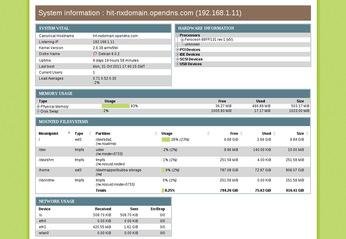Keep an Eye on Your Server with phpSysInfo

Productivity Sauce
Running a server on a local network opens a whole new world of possibilities. You can access your files and documents from multiple machines, stream media, host your own photo gallery or blog, and much more. This also means that you have to monitor your server to make sure it runs smoothly. There are quite a few server monitoring solutions out there, but most of them are overkill for keeping an eye on a single personal server. Enter phpSysInfo, a simple yet powerful script that displays essential system information in an easy-to-digest manner. The best part is that it requires virtually no configuration, and it can be deployed on your server in a matter of minutes. Grab the latest release of the software from the project's website, unpack the downloaded archive, rename the config.php.new file in the resulting directory to config.php and upload the entire phpsysinfo directory to your server. Point then the browser to http://127.0.0.1/phpsysinfo (replace 127.0.0.1 with the actual IP address or host name of your server) and you should see phpSysInfo in all its beauty.
The default phpSysInfo configuration displays all key information, but you can easily add more data points by editing the config.php file. All options available there contain brief but informative descriptions, so enabling and configuring the desired entries is easy. For example, to enable one or several bundled plugins edit the define('PSI_PLUGINS', false); line as in the example below:
define('PSI_PLUGINS', 'PS');phpSysInfo doesn't offer the flexibility or feature set of more advanced server monitoring solutions. But if you only want to be able to keep an eye on your personal server with a minimum of fuss, phpSysInfo is the perfect tool for the job.
Comments
comments powered by DisqusSubscribe to our Linux Newsletters
Find Linux and Open Source Jobs
Subscribe to our ADMIN Newsletters
Support Our Work
Linux Magazine content is made possible with support from readers like you. Please consider contributing when you’ve found an article to be beneficial.

News
-
Two New Distros Adopt Enlightenment
MX Moksha and AV Linux 25 join ranks with Bodhi Linux and embrace the Enlightenment desktop.
-
Solus Linux 4.8 Features Removes Python 2
Solus Linux 4.8 has been released with the latest Linux kernel, updated desktops, and a key removal.
-
Zorin OS 18 Hits over a Million Downloads
If you doubt Linux isn't gaining popularity, you only have to look at Zorin OS's download numbers.
-
TUXEDO Computers Scraps Snapdragon X1E-Based Laptop
Due to issues with a Snapdragon CPU, TUXEDO Computers has cancelled its plans to release a laptop based on this elite hardware.
-
Debian Unleashes Debian Libre Live
Debian Libre Live keeps your machine free of proprietary software.
-
Valve Announces Pending Release of Steam Machine
Shout it to the heavens: Steam Machine, powered by Linux, is set to arrive in 2026.
-
Happy Birthday, ADMIN Magazine!
ADMIN is celebrating its 15th anniversary with issue #90.
-
Another Linux Malware Discovered
Russian hackers use Hyper-V to hide malware within Linux virtual machines.
-
TUXEDO Computers Announces a New InfinityBook
TUXEDO Computers is at it again with a new InfinityBook that will meet your professional and gaming needs.
-
SUSE Dives into the Agentic AI Pool
SUSE becomes the first open source company to adopt agentic AI with SUSE Enterprise Linux 16.


PhPSysInfo